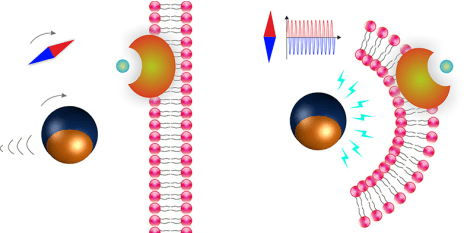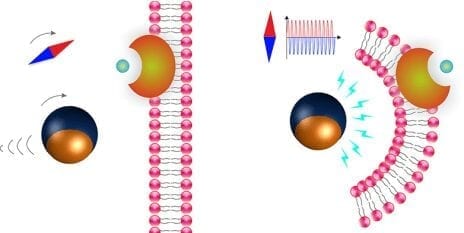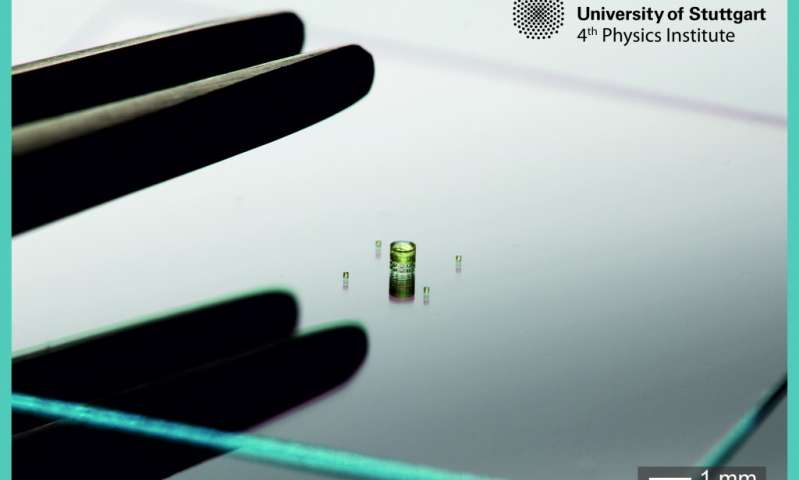
Micro and nanorobots that attack tumours with maximum precision using drugs: this is what the fight against cancer may look like in the future. A group of ETH researchers led by Salvador Pané are laying the foundations with magnetoelectric-controlled Janus machines
Salvador Pané was on a trolleybus in Zurich one day after work. He was deep in thought when the bus came to a sudden stop because the cable was disrupted. He was struck by an idea: “Why can’t we create a microrobot that generates an electric field wirelessly?” The idea stayed with him and, as a result, the ETH researcher and his colleagues have since succeeded in creating tiny particles that can be precisely controlled by magnetic fields and also generate electric fields.
This may sound relatively unspectacular to the uninitiated, but it is a breakthrough. What makes it unique is that a microstructure with a single source of energy is not only moved, but also can be brought to exercise another functionality. Until now, this had been possible only independently of each other. Pané and his team from the Institute of Robotics and Intelligent Systems have published their research results in the scientific journal Materials Horizons. Their findings could one day revolutionise medicine.
Like the layers of a lasagne
Pané, a chemist, has spent the past few years dealing with magnetoelectric micro and nanorobots, which can be stimulated by electromagnetic fields. Some of these materials are composed of different layers, with each exhibiting a different reaction to the magnetic field. “You have to imagine it like a lasagne with two layers: one layer responds to the field by changing its volume. These materials are magnetostrictive,” explains Pané. “Due to the stress transferred, the second piezoelectric layer becomes electrically polarized.
The scientists have made good use of this effect: they coated the microparticles on one side with two different metal layers, one of cobalt ferrite (magnetostrictive) and the other of barium titanate (piezoelectric) – two layers of the lasagne. When a magnetic field is generated around the particles, the inner layer of cobalt ferrite expands and the outer layer of barium titanate deforms, generating an electric field around the microparticles. The magnetoelectric effect was demonstrated by inducing electrochemical reactions.
Bringing drugs to their targets
The microrobots are named after Janus, the two-headed Roman god, because they are also composed of two halves. The Janus particles move by means of rotating magnetic fields. If the magnetic field is then altered, the microrobots generate an electric field. This opens up a wide range of applications, particularly in the field of medicine. “We could equip the microrobots with drugs, for example, and target them directly at cancerous tumours in the body, where they would then unload their cargo via the stimulus of the generated electric field,” explains Pané. “This would virtually eliminate the side-effects of cancer drugs because only the cancer cells would be attacked. In addition, the precise application would significantly increase the efficacy of cancer therapies.” However, other applications, such as the wireless electrical stimulation of cells, could expand regenerative medicine in a revolutionary way.
Much research before application
Many questions still have to be answered before the microrobots can actually be used as a vehicle to transport drugs. For example, it is not yet clear which is the most efficient structure of material combination with the highest magnetoelectric properties. In addition, the microrobots have to be tested for their compatibility with the human body. “A lot of experiments still need to be done,” says Pané. He cites corrosion as an example: “This is often overlooked at the micro and nanoscale, but it needs to be thoroughly investigated.” Corrosion is capable of affecting not only the function of a device but can also cause contamination.
“We have to look very carefully if we want to use a technology for a medical application,” emphasises the researcher. For this reason, in the development of micro and nanorobots his team is not limiting itself to technical feasibility alone, but is also exploring the compatibility, toxicity and efficiency of the robots. Pané is convinced that the microrobots will one day have the potential to make an important contribution in the field of biomedicine. It would be the (provisional) end of a journey that began on a Zurich trolleybus.
Learn more: Microagents with revolutionary potential
The Latest on: Microrobotic drug delivery
[google_news title=”” keyword=”microrobotic drug delivery” num_posts=”10″ blurb_length=”0″ show_thumb=”left”]
via Google News
The Latest on: Microrobotic drug delivery
- NTU scientists develop revolutionary drug delivery system inspired by caterpillarson May 7, 2024 at 8:47 pm
SINGAPORE: A team of scientists from Nanyang Technological University (NTU) has created a novel drug delivery system that draws inspiration from the natural world. Using the unique self-assembling ...
- Nature's Blueprint: Biodegradable Materials in Engineered Drug Delivery Systemson May 7, 2024 at 1:09 am
In the field of pharmaceutical sciences, drug is delivered either by conventional mode or controlled/ targeted mode to treat the disease. In controlled drug delivery, drug concentration is maintained ...
- Practical Considerations for Optimal Transdermal Drug Deliveryon May 5, 2024 at 5:00 pm
Medication patches are available in a limited number of dosage strengths. Occasionally, some patients require a different dosage of a medication than the dosages commercially available in patch ...
- Nose-to-brain drug delivery by HS15 micelles for brain targeting of insoluble drugon May 4, 2024 at 5:00 pm
Announcing a new publication for Acta Materia Medica journal. Agomelatine (AGO) is an antidepressant with limited clinical application due to its low bioavailability caused by poor water solubility, ...
- Drug Therapy During Labor and Delivery, Part 1on May 2, 2024 at 5:00 pm
Purpose: The drug therapy of common conditions and complications during labor and delivery and the fetal and neonatal effects of this therapy are examined. Summary: The pharmacologic therapy of ...
- Turning microalgae into light-controlled, soft bio-microrobotson April 4, 2024 at 8:03 am
They have successfully demonstrated the task execution capability of targeted drug delivery and selective ... soft microrobot provides a new bio-microrobotic tool that can execute multiple tasks ...
- Drug Delivery News and Researchon March 24, 2024 at 5:00 pm
University of North Carolina at Chapel Hill researchers have developed a new drug delivery platform that harnesses helical amyloid fibers designed to untwist and release drugs in response to body ...
- Transdermal and Microneedle Drug Delivery 2023on October 11, 2022 at 5:00 pm
The 2023 Transdermal and Microneedle Drug Delivery Conference will explore real world applications of microneedles in drug delivery and strategies for advanced and user-centric device design.
- Microrobots in swarms for medical embolizationon July 29, 2022 at 4:50 pm
Microrobotic agents can form swarms of targeted drug delivery for improved imaging analyses. In a new report now published in Science Advances, Junhui Law and a team of researchers in mechanical ...
- Injectable Drug Delivery 2022on February 2, 2022 at 4:01 pm
Innovations in Formulation and Device Design for Enhanced Subcutaneous Delivery As Part of Europe’s leading Injectable conference series, we will assess innovations in drug product formulation ...
via Bing News











